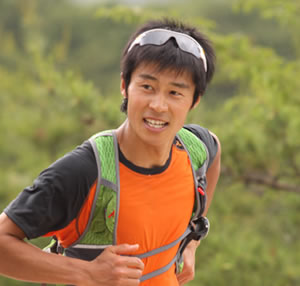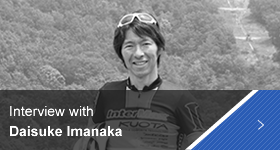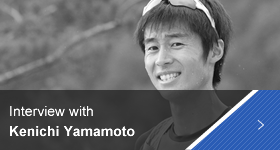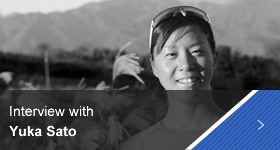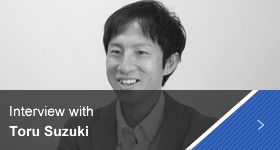Main content starts here.
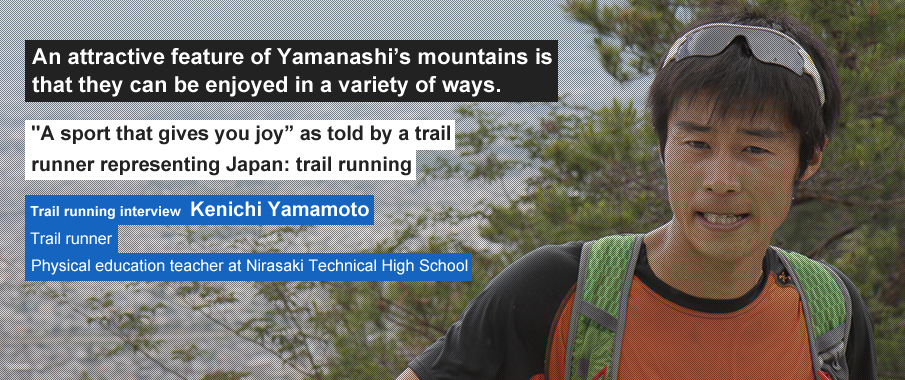
Trail running seemed to be a free type of sport.
Please tell us about yourself. Are you originally from Yamanashi? What type of child were you?
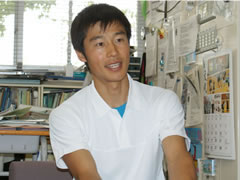 I am originally from Nirasaki City, Yamanashi. I played soccer when I was in elementary school. My interest changed to running, so I joined the track and field club in junior high school and the mountaineering club in high school. I joined the mountaineering club because I wanted to become the best in Japan at something. I was wondering if I could participate in some type of inter-high school competition. I learned that that would probably be possible if I joined the mountaineering club. Nirasaki High School was the best in the country at that time.
I am originally from Nirasaki City, Yamanashi. I played soccer when I was in elementary school. My interest changed to running, so I joined the track and field club in junior high school and the mountaineering club in high school. I joined the mountaineering club because I wanted to become the best in Japan at something. I was wondering if I could participate in some type of inter-high school competition. I learned that that would probably be possible if I joined the mountaineering club. Nirasaki High School was the best in the country at that time.
What was your impression of the mountaineering club?
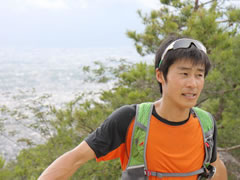 I expected mountaineering to be a minor sport, but there were many members. I was surprised by how popular the club was. There were even female members. In track and field, the main activity is running on the schoolyard track in order to improve your times. In the mountaineering club, the main difference was that you are running outside the school rather than on a track. And you run around without worrying about your time. It seemed to be a free type of sport. We would train as part of the club on a day-to-day basis, and then during long breaks such as summer break and on weekends, our teachers would take us to the mountains. The training camps were fun. There were competitions, including inter-high school competitions. If you are just doing the sport for fun, you might not devote yourself to it very much. The competitions were what motivated me to set goals.
I expected mountaineering to be a minor sport, but there were many members. I was surprised by how popular the club was. There were even female members. In track and field, the main activity is running on the schoolyard track in order to improve your times. In the mountaineering club, the main difference was that you are running outside the school rather than on a track. And you run around without worrying about your time. It seemed to be a free type of sport. We would train as part of the club on a day-to-day basis, and then during long breaks such as summer break and on weekends, our teachers would take us to the mountains. The training camps were fun. There were competitions, including inter-high school competitions. If you are just doing the sport for fun, you might not devote yourself to it very much. The competitions were what motivated me to set goals.
I am currently doing the same thing that I used to do in high school (laughs).
When you compete in mountaineering, how is this done?
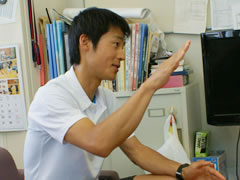 The competition is related to your overall mountain climbing skills – your physical strength and your knowledge regarding the mountains. You listen to the radio, draw a weather map, and make a weather forecast. You forecast the weather for the day of the competition based on a strong rationale, such as the fact that if moist air comes in from the south, it will hit the mountains and likely create fog and rain. Everything related to mountain climbing is checked, including whether your tent has been put up sturdily, and whether your cooking has been performed hygienically and efficiently. I currently teach these things as an advisor to the mountaineering and skiing club at Nirasaki Technical High School. I am currently doing the same thing that I used to do in high school (laughs).
The competition is related to your overall mountain climbing skills – your physical strength and your knowledge regarding the mountains. You listen to the radio, draw a weather map, and make a weather forecast. You forecast the weather for the day of the competition based on a strong rationale, such as the fact that if moist air comes in from the south, it will hit the mountains and likely create fog and rain. Everything related to mountain climbing is checked, including whether your tent has been put up sturdily, and whether your cooking has been performed hygienically and efficiently. I currently teach these things as an advisor to the mountaineering and skiing club at Nirasaki Technical High School. I am currently doing the same thing that I used to do in high school (laughs).
What made you want to do trail running seriously?
 After graduating from university in Nagano, I worked as a part-time teacher at elementary and junior high schools, and participated in skiing mogul competitions. When I was training at a park one summer, a middle-aged man from the neighborhood started a conversation with me. When I said I was in the mountaineering club in high school, he told me about a race I could enter. This was the “Japan Mountain Endurance Race,” also known as the “Hasetsune Cup.” I entered the next year. The distance was 72 km.
After graduating from university in Nagano, I worked as a part-time teacher at elementary and junior high schools, and participated in skiing mogul competitions. When I was training at a park one summer, a middle-aged man from the neighborhood started a conversation with me. When I said I was in the mountaineering club in high school, he told me about a race I could enter. This was the “Japan Mountain Endurance Race,” also known as the “Hasetsune Cup.” I entered the next year. The distance was 72 km.
Had you run long distances in your training before that time?
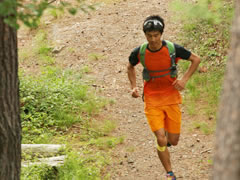 No, I had not! The competition for Nirasaki High School has a distance of 62 km. You run to Lake Suwako. I recalled my experience in high school regarding that distance over 50 km. At that time I was a beginner at trail running. But out of about 2,000 participants, I finished between 20th and 30th place. I think I came in 26th place. I got the sense that I might be good at this sport and that it could get interesting if I trained a little bit more. I entered the race again the next year. The man I met is an amazing guy, and we still keep in touch. He mainly does mountain climbing, but also does trail running for training purposes. We recently went mountain climbing together to celebrate his 60th birthday. We have many memories together, including running up Mt. Yarigatake.
No, I had not! The competition for Nirasaki High School has a distance of 62 km. You run to Lake Suwako. I recalled my experience in high school regarding that distance over 50 km. At that time I was a beginner at trail running. But out of about 2,000 participants, I finished between 20th and 30th place. I think I came in 26th place. I got the sense that I might be good at this sport and that it could get interesting if I trained a little bit more. I entered the race again the next year. The man I met is an amazing guy, and we still keep in touch. He mainly does mountain climbing, but also does trail running for training purposes. We recently went mountain climbing together to celebrate his 60th birthday. We have many memories together, including running up Mt. Yarigatake.
Yamanashi has many types of mountains so it never gets boring.
How do you usually train? Do you mostly run around the Nirasaki area?
What do you find attractive amount the mountains of Yamanashi compared to other courses in Japan and overseas?
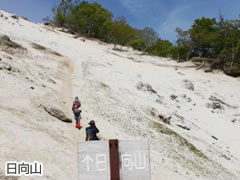 For training, I often run around the Nirasaki area. Mt. Amarisan is close by, and there are many mountains so there are a lot of good courses. Yamanashi has many types of mountains, ranging from small mountains in woodland areas to Japan’s tallest mountain Mt. Fuji, so there are many ways to enjoy the mountains throughout the prefecture and it never gets boring. I only train in Yamanashi. Mt. Kaikomagatake in the Minami Alps has a very steep and long ridge. It is actually longer than Mt. Fuji’s. When you start climbing from the bottom of Mt. Kaikomagatake, you suddenly go from a moss-covered forest area past the forest limit into a barren mountain area with just rocks. Mt. Hinatayama has sandy soil near its peak so it looks very strange. I sometimes run around the rim at the top of Mt. Fuji. This is high-altitude training at the highest elevation in Japan. Even during the middle of summer, it is not crowded with people in the daytime, so it is surprisingly easy to run there.
For training, I often run around the Nirasaki area. Mt. Amarisan is close by, and there are many mountains so there are a lot of good courses. Yamanashi has many types of mountains, ranging from small mountains in woodland areas to Japan’s tallest mountain Mt. Fuji, so there are many ways to enjoy the mountains throughout the prefecture and it never gets boring. I only train in Yamanashi. Mt. Kaikomagatake in the Minami Alps has a very steep and long ridge. It is actually longer than Mt. Fuji’s. When you start climbing from the bottom of Mt. Kaikomagatake, you suddenly go from a moss-covered forest area past the forest limit into a barren mountain area with just rocks. Mt. Hinatayama has sandy soil near its peak so it looks very strange. I sometimes run around the rim at the top of Mt. Fuji. This is high-altitude training at the highest elevation in Japan. Even during the middle of summer, it is not crowded with people in the daytime, so it is surprisingly easy to run there.
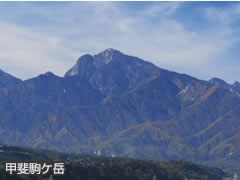 The mountain I like the best is Mt. Kaikomagatake. It is nice to be able to climb the long ridge. There is Ojiragawa River nearby, so after running to the top, when you come back down you can jump straight into the river. This is great because you can instantly cool down your body when it is hot from running. The mountain I climb the most frequently is Mt. Kayagatake in Nirasaki. I have climbed it over 200 times since my high school days. It is a small mountain but is enjoyable because there are many different options, including a relaxing course through a valley and a course up a ridge.
The mountain I like the best is Mt. Kaikomagatake. It is nice to be able to climb the long ridge. There is Ojiragawa River nearby, so after running to the top, when you come back down you can jump straight into the river. This is great because you can instantly cool down your body when it is hot from running. The mountain I climb the most frequently is Mt. Kayagatake in Nirasaki. I have climbed it over 200 times since my high school days. It is a small mountain but is enjoyable because there are many different options, including a relaxing course through a valley and a course up a ridge.
Going to the mountains gives you a good heart and humility.
What is the difference between trail running, and running marathons on level ground?
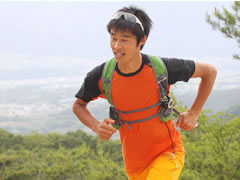 The difference compared to regular running is that the changes are more significant. The changes in scenery are significant, and with trail running, there are differences in elevation, so there is a greater sense of achievement and satisfaction. Mountain climbing involves walking while wearing heavy shoes and carrying heavy gear. Trail running has a more casual feel than mountain climbing because you wear lightweight shoes and carry only the minimum necessary gear. Essentially walking is acceptable, but it is better to run at the level areas and gradual downhill areas. When you are running through the forest, you get a sense of speed. I think that aspect is enjoyable.
The difference compared to regular running is that the changes are more significant. The changes in scenery are significant, and with trail running, there are differences in elevation, so there is a greater sense of achievement and satisfaction. Mountain climbing involves walking while wearing heavy shoes and carrying heavy gear. Trail running has a more casual feel than mountain climbing because you wear lightweight shoes and carry only the minimum necessary gear. Essentially walking is acceptable, but it is better to run at the level areas and gradual downhill areas. When you are running through the forest, you get a sense of speed. I think that aspect is enjoyable.
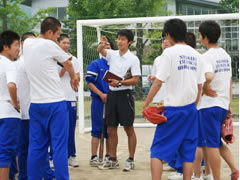 I recently took about 70 high school students to Yatsugatake for trail running. They were gleeful and said they had a lot of fun. On the way down, you can go fast even without running very hard, so you can get a sense of speed. I think that this is one attractive aspect of this sport. Unlike on asphalt, the path is uneven and constantly changing, so there is a higher risk of getting an injury such as a sprained ankle. If you go trail running, please make sure take sufficient precautions, such as putting wraps on your ankles to support them. The other thing you need in order to avoid injuring yourself is concentration. Look carefully at the ground. You should only look at the scenery when ascending, because on the way down, it is dangerous if you aren’t watching your step.
I recently took about 70 high school students to Yatsugatake for trail running. They were gleeful and said they had a lot of fun. On the way down, you can go fast even without running very hard, so you can get a sense of speed. I think that this is one attractive aspect of this sport. Unlike on asphalt, the path is uneven and constantly changing, so there is a higher risk of getting an injury such as a sprained ankle. If you go trail running, please make sure take sufficient precautions, such as putting wraps on your ankles to support them. The other thing you need in order to avoid injuring yourself is concentration. Look carefully at the ground. You should only look at the scenery when ascending, because on the way down, it is dangerous if you aren’t watching your step.
What is a uniquely attractive aspect of trail running for you?
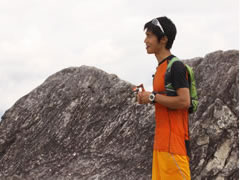 It is the time when I have climbed to the peak and am looking out at the beautiful view and chatting with friends while drinking water and eating snacks. I think mountain climbing makes up a stronger part of my character than racing. When you go to the mountains, you greet the other runners and the officials and staff members of competitions. You naturally feel like saying “hi.” I get the impression that going to the mountains gives you a good heart. It also gives you humility. The environment is very different in the mountains than when running a marathon in a town, and this tends to naturally give you humility.
It is the time when I have climbed to the peak and am looking out at the beautiful view and chatting with friends while drinking water and eating snacks. I think mountain climbing makes up a stronger part of my character than racing. When you go to the mountains, you greet the other runners and the officials and staff members of competitions. You naturally feel like saying “hi.” I get the impression that going to the mountains gives you a good heart. It also gives you humility. The environment is very different in the mountains than when running a marathon in a town, and this tends to naturally give you humility.
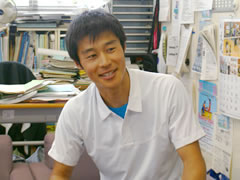 Sometimes you talk with your friends during races. Even when overseas, sometimes top-level runners talk with each other. People say, “How are you doing?” Running together while communicating with each other is one very enjoyable aspect of this sport. On television, I have never seen top-level marathon runners running while talking to each other, but this is very common in the mountains. I think it is a very cheery sport. There is a friendly atmosphere, so it is sport that makes you happy. I think this could be a sport that will invigorate today’s Japan.
Sometimes you talk with your friends during races. Even when overseas, sometimes top-level runners talk with each other. People say, “How are you doing?” Running together while communicating with each other is one very enjoyable aspect of this sport. On television, I have never seen top-level marathon runners running while talking to each other, but this is very common in the mountains. I think it is a very cheery sport. There is a friendly atmosphere, so it is sport that makes you happy. I think this could be a sport that will invigorate today’s Japan.
Profile of Kenichi Yamamoto
Mr. Yamamoto was born in Nirasaki City, Yamanashi Prefecture in 1979. He is working as a physical education teacher at Yamanashi Prefecture Nirasaki Technical High School, and has participated in numerous trail races as a trail runner. Mr. Yamamoto took third place, the top spot for Japan, in “Ultra-Trail Mt. Fuji” in May 2012, and in August of that year, he became the first Japanese person to win the “Grand Raid of the Pyrenees.”
